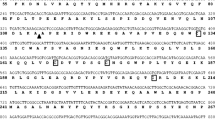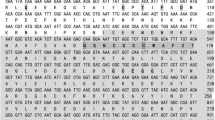Abstract
Hookworm infection is still a public health problem in developing countries. Aspartic protease plays an important role in parasite invasion and migration in the host. Aspartic protease gene from Ancylostoma caninum has been reported (Biochem Biophys Res Commun 227:294–302, 1996), but the activity of Acasp in eggs and larvae stage has not been studied. This paper reported the cloning of Acasp, expression in Escherichia coli, and characterization in eggs and larval stage. The mRNA encoding Acasp was detected using reverse transcriptase polymerase chain reaction in L4 and adult worm. A polyclonal antiserum against E. coli expressed recombinant Acasp was produced and used to detect and localize the Acasp in various developmental stages of A. caninum. Results from Western blot and indirect fluorescent immunoassay showed that the Acasp was present in the embryo, larvae, as well as in the adult worms. The recombinant Acasp exhibited the protease activity by the gelatin gel digestion assay.





Similar content being viewed by others
References
Becker MM, Harrop SA, Dalton JP, Kalinna BH, McManus DP, Brindley PJ (1995) Cloning and characterization of the Schistosoma japonicum aspartic proteinase involved in hemoglobin degradation. J Biol Chem 270:24496–24501
Bowerman B, Draper BW, Mello CC, Priess JR (1993) The maternal gene skn-1 encodes a protein that is distributed unequally in early C. elegans embryos. Cell 74:443–452
Brown A, Girod N, Billett EE, Pritchard DI (1999) Necator americanus (human hookworm) aspartyl proteinases and digestion of skin macromolecules during skin penetration. Am J Trop Med Hyg 60:840–847
Crittenden SL, Troemel ER, Evans TC, Kimble J (1994) GLP-1 is localized to the mitotic region of the C. elegans germ line. Development 120:2901–2911
Gallego SG, Slade RW, Brindley PJ (1998) A cDNA encoding a pepsinogen-like, aspartic protease from the human roundworm parasite Strongyloides stercoralis. Acta Trop 71:17–26
Geier G, Banaj HJ, Heid H, Bini L, Pallini V, Zwilling R (1999) Aspartyl proteases in Caenorhabditis elegans. Isolation, identification and characterization by a combined use of affinity chromatography, two-dimensional gel electrophoresis, microsequencing and databank analysis. Eur J Biochem 264:872–879
Harrop SA, Prociv P, Brindley PJ (1996) Acasp, a gene encoding a cathepsin D-like aspartic protease from the hookworm Ancylostoma caninum. Biochem Biophys Res Commun 227:294–302
Hunter CP, Kenyon C (1996) Spatial and temporal controls target pal-1 blastomere-specification activity to a single blastomere lineage in C. elegans embryos. Cell 87:217–226
Jolodar A, Miller DJ (1997) Preliminary characterisation of an Onchocerca volvulus aspartic protease. Int J Parasitol 27:1087–1090
Jolodar A, Miller DJ (1998) Identification of a novel family of non-lysosomal aspartic proteases in nematodes. Biochim Biophys Acta 1382:13–16
Jolodar A, Fischer P, Buttner DW, Miller DJ, Schmetz C, Brattig NW (2004) Onchocerca volvulus: expression and immunolocalization of a nematode cathepsin D-like lysosomal aspartic protease. Exp Parasitol 107:145–156
Longbottom D, Redmond DL, Russell M, Liddell S, Smith WD, Knox DP (1997) Molecular cloning and characterisation of a putative aspartate proteinase associated with a gut membrane protein complex from adult Haemonchus contortus. Mol Biochem Parasitol 88:63–72
Loukas A, Bethony JM, Mendez S, Fujiwara RT, Goud GN, Ranjit N, Zhan B, Jones K, Bottazzi ME, Hotez PJ (2005) Vaccination with recombinant aspartic hemoglobinase reduces parasite load and blood loss after hookworm infection in dogs. PLoS Med 2:e295
Samara C, Tavernarakis N (2003) Calcium-dependent and aspartyl proteases in neurodegeneration and ageing in C. elegans. Ageing Res Rev 2:451–471
Sarkis GJ, Ashcom JD, Hawdon JM, Jacobson LA (1988) Decline in protease activities with age in the nematode Caenorhabditis elegans. Mech Ageing Dev 45:191–201
Schulmeister A, Heyers O, Morales ME, Brindley PJ, Lucius R, Meusel G, Kalinna BH (2005) Organization and functional analysis of the Schistosoma mansoni cathepsin D-like aspartic protease gene promoter. Biochim Biophys Acta 1727:27–34
Smith WD, Skuce PJ, Newlands GF, Smith SK, Pettit D (2003) Aspartyl proteases from the intestinal brush border of Haemonchus contortus as protective antigens for sheep. Parasite Immunol 25:521–530
Syntichaki P, Xu K, Driscoll M, Tavernarakis N (2002) Specific aspartyl and calpain proteases are required for neurodegeneration in C. elegans. Nature 419:939–944
Tcherepanova I, Bhattacharyya L, Rubin CS, Freedman JH (2000) Aspartic proteases from the nematode Caenorhabditis elegans. Structural organization and developmental and cell-specific expression of asp-1. J Biol Chem 275:26359–26369
Williamson AL, Brindley PJ, Abbenante G, Prociv P, Berry C, Girdwood K, Pritchard DI, Fairlie DP, Hotez PJ, Dalton JP, Loukas A (2002) Cleavage of hemoglobin by hookworm cathepsin D aspartic proteases and its potential contribution to host specificity. FASEB J 16:1458–1460
Williamson AL, Brindley PJ, Abbenante G, Datu BJ, Prociv P, Berry C, Girdwood K, Pritchard DI, Fairlie DP, Hotez PJ, Zhan B, Loukas A (2003a) Hookworm aspartic protease, Na-APR-2, cleaves human hemoglobin and serum proteins in a host-specific fashion. J Infect Dis 187:484–494
Williamson AL, Brindley PJ, Loukas A (2003b) Hookworm cathepsin D aspartic proteases: contributing roles in the host-specific degradation of serum proteins and skin macromolecules. Parasitology 126:179–185
Wilson LR, Good RT, Panaccio M, Wijffels GL, Sandeman RM, Spithill TW (1998) Fasciola hepatica: characterization and cloning of the major cathepsin B protease secreted by newly excysted juvenile liver fluke. Exp Parasitol 88:85–94
Acknowledgements
This work was supported by the Funding of Fujian province Natural Science Foundation (C0320001) and a grant from Xiamen Science Technology program (3502Z20061098) to YRY, and partial support from an Innovation grant of Science and Technology Foundation (06C26223511306) and the New Century Talents Support Program from Xiamen University to YRY. We thank Dr. Xin-zhuan Su for manuscript revision and comments.
Author information
Authors and Affiliations
Corresponding author
Rights and permissions
About this article
Cite this article
Yang, Y., Wei, H., Qin, W. et al. Expression and characterization of aspartic protease gene in eggs and larvae stage of Ancylostoma caninum . Parasitol Res 104, 1327–1333 (2009). https://doi.org/10.1007/s00436-009-1332-1
Received:
Accepted:
Published:
Issue Date:
DOI: https://doi.org/10.1007/s00436-009-1332-1




